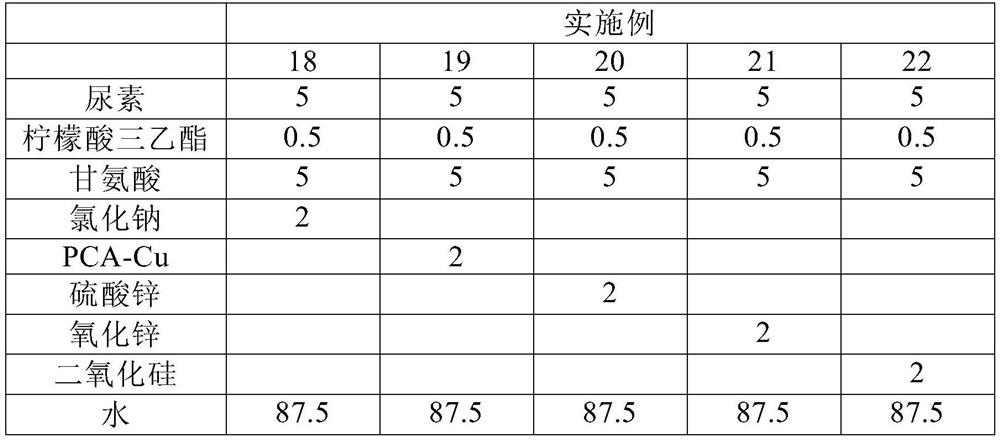Stabilizing composition containing triethyl citrate and glycine
A technology of triethyl citrate and composition, applied in the field of stable compositions containing triethyl citrate and glycine, capable of solving problems such as urea instability limiting application
- Summary
- Abstract
- Description
- Claims
- Application Information
AI Technical Summary
Problems solved by technology
Method used
Image
Examples
Embodiment 1-22
[0089] Examples 1-22: Preparation of urea-containing compositions
[0090] Weigh an appropriate amount of raw materials according to the weight shown in Table 1-3, add them to a 50ml PET sealed plastic bottle, weigh an appropriate amount of deionized water, add the PET sealed plastic bottle, seal the PET sealed plastic bottle, and shake until the solid is completely dissolve. After the solid is completely dissolved and mixed evenly, measure the pH value of the sample. If the initial pH value is higher than 7, add citric acid solution to make the pH value of the sample reach about 6.
[0091] Table 1
[0092]
[0093] Table 2
[0094]
[0095] table 3
[0096]
[0097] The dosage unit of each component in the above examples is g.
[0098] The above-described embodiments can be divided into four groups:
[0099] (1) Example 1-Example 4: urea background, use of triethyl citrate or glycine alone, and comparison of the effects of using triethyl citrate and glycine aft...
Embodiment 18- Embodiment 22
[0102] (4) Example 18-Example 22: The content of triethyl citrate and glycine was fixed, and the effects of electrolytes, excessive metal ions, and solid powder on the pH value of urea aqueous solution were investigated.
[0103] Due to the good solubility of urea, triethyl citrate, and glycine, most of the samples can be completely dissolved by shaking a few times to form a transparent and clear solution. Exceptions include, Example 19, which was dark blue due to the addition of copper salt, and Examples 21 and 22, which appeared as suspensions due to the addition of water-insoluble powder.
[0104] The pH of most samples after preparation is between 4.0 and 7, and there is no need to adjust the pH value after preparation. Yet embodiment 6 and embodiment 21 make pH value higher than 6.5 because of adding alkaline component, and add citric acid to adjust pH value. The pH value of the solution after preparation in Example 6 was 11.21, and the pH value after adding citric acid ...
Embodiment 23
[0132] Example 23: Preparation of preforms for cosmetic formulations
[0133] Add the raw materials of phase A into a 1000mL glass beaker according to the dosage shown in Table 7, seal it with plastic wrap, and preheat the water bath at 90°C for 30min. Add the phase B raw materials into a 500mL glass beaker according to the dosage shown in Table 7, seal it with plastic wrap, and preheat the water bath at 90°C for 30min.
[0134] After the preheating of phase A is completed, take it out of the water bath, and homogenize it at a speed of 5000 rpm for 2 minutes, until the material is uniform. Thereafter, slowly add phase B to phase A under homogeneous stirring at 5000rpm (1 minute to complete the addition), and keep homogenizing at 5000rpm for 2 minutes after the addition is completed until the material body is uniform. After homogenization, the beaker was sealed with plastic wrap for later use.
[0135] Table 7
[0136]
PUM
| Property | Measurement | Unit |
|---|---|---|
| viscosity | aaaaa | aaaaa |
| viscosity | aaaaa | aaaaa |
| viscosity | aaaaa | aaaaa |
Abstract
Description
Claims
Application Information
 Login to View More
Login to View More - R&D
- Intellectual Property
- Life Sciences
- Materials
- Tech Scout
- Unparalleled Data Quality
- Higher Quality Content
- 60% Fewer Hallucinations
Browse by: Latest US Patents, China's latest patents, Technical Efficacy Thesaurus, Application Domain, Technology Topic, Popular Technical Reports.
© 2025 PatSnap. All rights reserved.Legal|Privacy policy|Modern Slavery Act Transparency Statement|Sitemap|About US| Contact US: help@patsnap.com



